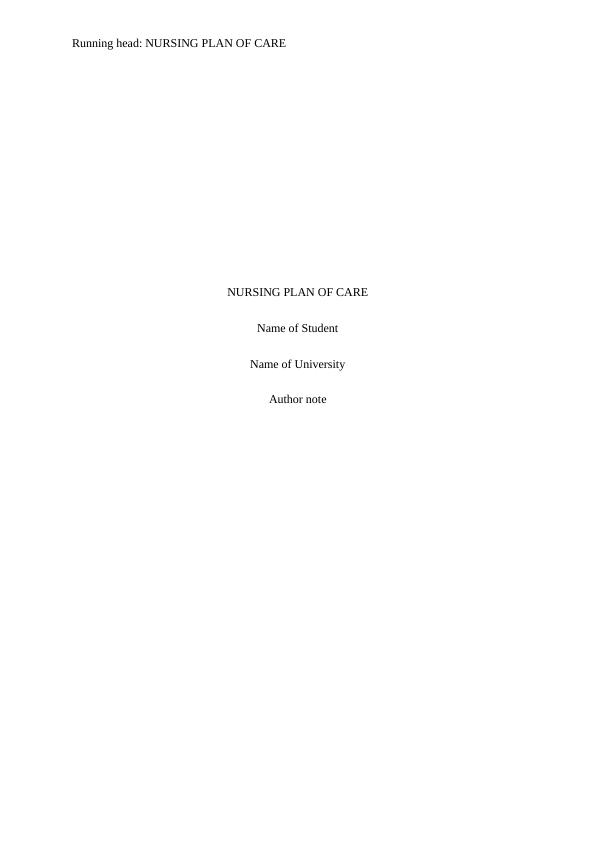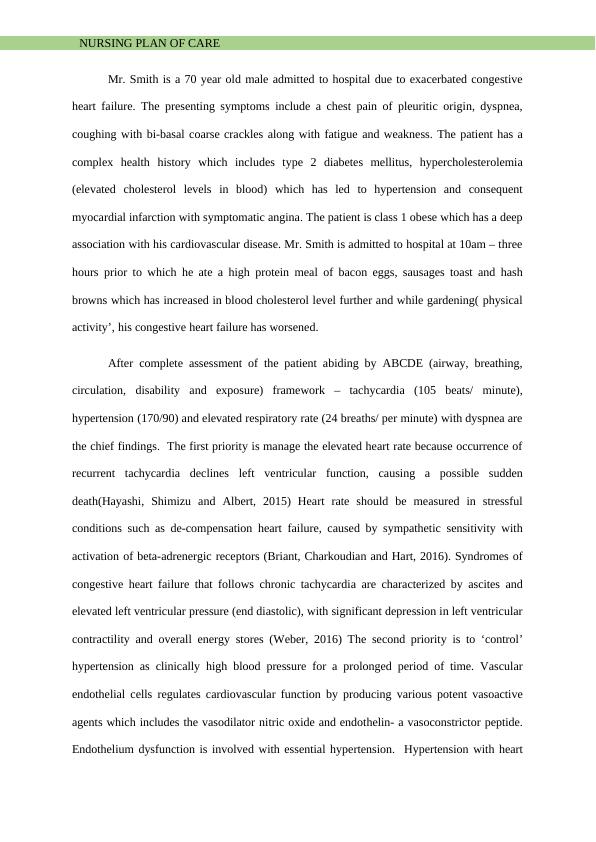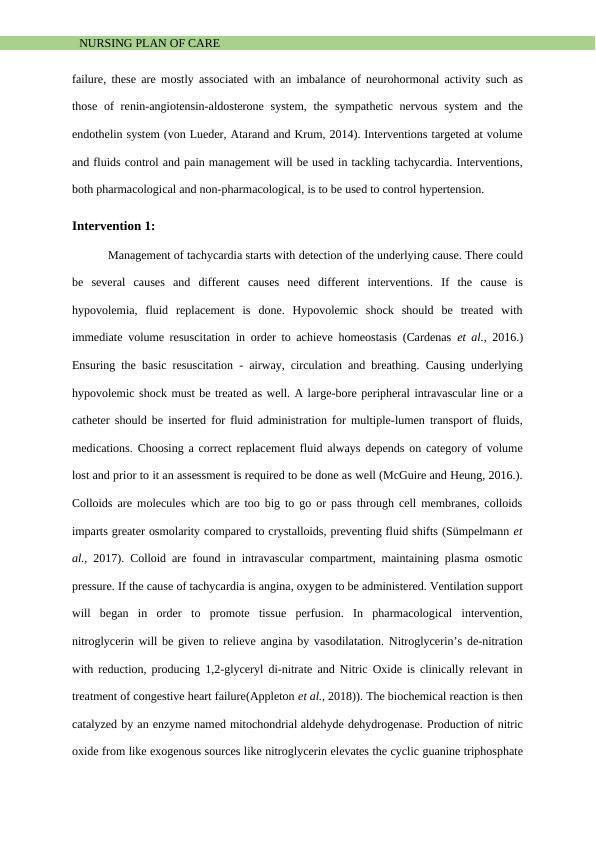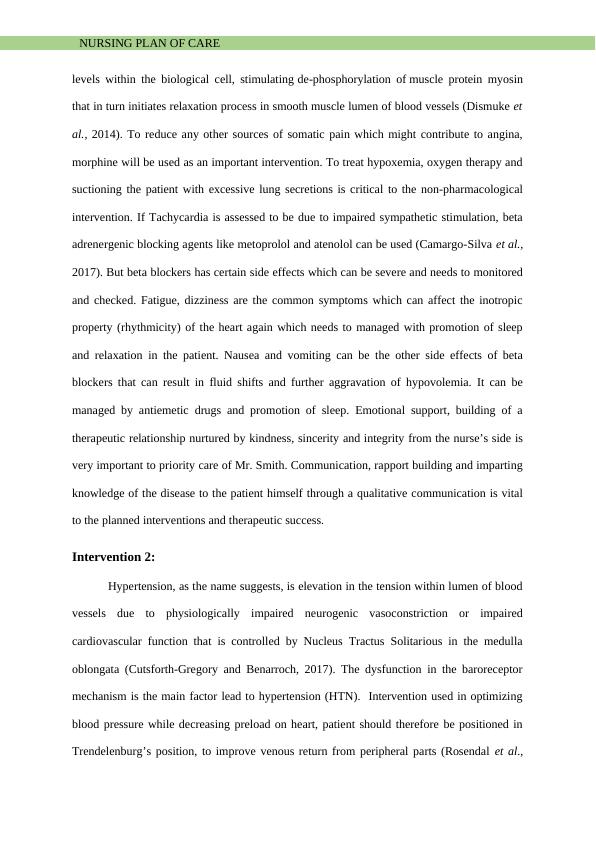Nursing Plan of Care for Exacerbated Congestive Heart Failure
Added on 2023-01-16
11 Pages3154 Words26 Views
Running head: NURSING PLAN OF CARE
NURSING PLAN OF CARE
Name of Student
Name of University
Author note
NURSING PLAN OF CARE
Name of Student
Name of University
Author note

NURSING PLAN OF CARE
Mr. Smith is a 70 year old male admitted to hospital due to exacerbated congestive
heart failure. The presenting symptoms include a chest pain of pleuritic origin, dyspnea,
coughing with bi-basal coarse crackles along with fatigue and weakness. The patient has a
complex health history which includes type 2 diabetes mellitus, hypercholesterolemia
(elevated cholesterol levels in blood) which has led to hypertension and consequent
myocardial infarction with symptomatic angina. The patient is class 1 obese which has a deep
association with his cardiovascular disease. Mr. Smith is admitted to hospital at 10am – three
hours prior to which he ate a high protein meal of bacon eggs, sausages toast and hash
browns which has increased in blood cholesterol level further and while gardening( physical
activity’, his congestive heart failure has worsened.
After complete assessment of the patient abiding by ABCDE (airway, breathing,
circulation, disability and exposure) framework – tachycardia (105 beats/ minute),
hypertension (170/90) and elevated respiratory rate (24 breaths/ per minute) with dyspnea are
the chief findings. The first priority is manage the elevated heart rate because occurrence of
recurrent tachycardia declines left ventricular function, causing a possible sudden
death(Hayashi, Shimizu and Albert, 2015) Heart rate should be measured in stressful
conditions such as de-compensation heart failure, caused by sympathetic sensitivity with
activation of beta-adrenergic receptors (Briant, Charkoudian and Hart, 2016). Syndromes of
congestive heart failure that follows chronic tachycardia are characterized by ascites and
elevated left ventricular pressure (end diastolic), with significant depression in left ventricular
contractility and overall energy stores (Weber, 2016) The second priority is to ‘control’
hypertension as clinically high blood pressure for a prolonged period of time. Vascular
endothelial cells regulates cardiovascular function by producing various potent vasoactive
agents which includes the vasodilator nitric oxide and endothelin- a vasoconstrictor peptide.
Endothelium dysfunction is involved with essential hypertension. Hypertension with heart
Mr. Smith is a 70 year old male admitted to hospital due to exacerbated congestive
heart failure. The presenting symptoms include a chest pain of pleuritic origin, dyspnea,
coughing with bi-basal coarse crackles along with fatigue and weakness. The patient has a
complex health history which includes type 2 diabetes mellitus, hypercholesterolemia
(elevated cholesterol levels in blood) which has led to hypertension and consequent
myocardial infarction with symptomatic angina. The patient is class 1 obese which has a deep
association with his cardiovascular disease. Mr. Smith is admitted to hospital at 10am – three
hours prior to which he ate a high protein meal of bacon eggs, sausages toast and hash
browns which has increased in blood cholesterol level further and while gardening( physical
activity’, his congestive heart failure has worsened.
After complete assessment of the patient abiding by ABCDE (airway, breathing,
circulation, disability and exposure) framework – tachycardia (105 beats/ minute),
hypertension (170/90) and elevated respiratory rate (24 breaths/ per minute) with dyspnea are
the chief findings. The first priority is manage the elevated heart rate because occurrence of
recurrent tachycardia declines left ventricular function, causing a possible sudden
death(Hayashi, Shimizu and Albert, 2015) Heart rate should be measured in stressful
conditions such as de-compensation heart failure, caused by sympathetic sensitivity with
activation of beta-adrenergic receptors (Briant, Charkoudian and Hart, 2016). Syndromes of
congestive heart failure that follows chronic tachycardia are characterized by ascites and
elevated left ventricular pressure (end diastolic), with significant depression in left ventricular
contractility and overall energy stores (Weber, 2016) The second priority is to ‘control’
hypertension as clinically high blood pressure for a prolonged period of time. Vascular
endothelial cells regulates cardiovascular function by producing various potent vasoactive
agents which includes the vasodilator nitric oxide and endothelin- a vasoconstrictor peptide.
Endothelium dysfunction is involved with essential hypertension. Hypertension with heart

NURSING PLAN OF CARE
failure, these are mostly associated with an imbalance of neurohormonal activity such as
those of renin-angiotensin-aldosterone system, the sympathetic nervous system and the
endothelin system (von Lueder, Atarand and Krum, 2014). Interventions targeted at volume
and fluids control and pain management will be used in tackling tachycardia. Interventions,
both pharmacological and non-pharmacological, is to be used to control hypertension.
Intervention 1:
Management of tachycardia starts with detection of the underlying cause. There could
be several causes and different causes need different interventions. If the cause is
hypovolemia, fluid replacement is done. Hypovolemic shock should be treated with
immediate volume resuscitation in order to achieve homeostasis (Cardenas et al., 2016.)
Ensuring the basic resuscitation - airway, circulation and breathing. Causing underlying
hypovolemic shock must be treated as well. A large-bore peripheral intravascular line or a
catheter should be inserted for fluid administration for multiple-lumen transport of fluids,
medications. Choosing a correct replacement fluid always depends on category of volume
lost and prior to it an assessment is required to be done as well (McGuire and Heung, 2016.).
Colloids are molecules which are too big to go or pass through cell membranes, colloids
imparts greater osmolarity compared to crystalloids, preventing fluid shifts (Sümpelmann et
al., 2017). Colloid are found in intravascular compartment, maintaining plasma osmotic
pressure. If the cause of tachycardia is angina, oxygen to be administered. Ventilation support
will began in order to promote tissue perfusion. In pharmacological intervention,
nitroglycerin will be given to relieve angina by vasodilatation. Nitroglycerin’s de-nitration
with reduction, producing 1,2-glyceryl di-nitrate and Nitric Oxide is clinically relevant in
treatment of congestive heart failure(Appleton et al., 2018)). The biochemical reaction is then
catalyzed by an enzyme named mitochondrial aldehyde dehydrogenase. Production of nitric
oxide from like exogenous sources like nitroglycerin elevates the cyclic guanine triphosphate
failure, these are mostly associated with an imbalance of neurohormonal activity such as
those of renin-angiotensin-aldosterone system, the sympathetic nervous system and the
endothelin system (von Lueder, Atarand and Krum, 2014). Interventions targeted at volume
and fluids control and pain management will be used in tackling tachycardia. Interventions,
both pharmacological and non-pharmacological, is to be used to control hypertension.
Intervention 1:
Management of tachycardia starts with detection of the underlying cause. There could
be several causes and different causes need different interventions. If the cause is
hypovolemia, fluid replacement is done. Hypovolemic shock should be treated with
immediate volume resuscitation in order to achieve homeostasis (Cardenas et al., 2016.)
Ensuring the basic resuscitation - airway, circulation and breathing. Causing underlying
hypovolemic shock must be treated as well. A large-bore peripheral intravascular line or a
catheter should be inserted for fluid administration for multiple-lumen transport of fluids,
medications. Choosing a correct replacement fluid always depends on category of volume
lost and prior to it an assessment is required to be done as well (McGuire and Heung, 2016.).
Colloids are molecules which are too big to go or pass through cell membranes, colloids
imparts greater osmolarity compared to crystalloids, preventing fluid shifts (Sümpelmann et
al., 2017). Colloid are found in intravascular compartment, maintaining plasma osmotic
pressure. If the cause of tachycardia is angina, oxygen to be administered. Ventilation support
will began in order to promote tissue perfusion. In pharmacological intervention,
nitroglycerin will be given to relieve angina by vasodilatation. Nitroglycerin’s de-nitration
with reduction, producing 1,2-glyceryl di-nitrate and Nitric Oxide is clinically relevant in
treatment of congestive heart failure(Appleton et al., 2018)). The biochemical reaction is then
catalyzed by an enzyme named mitochondrial aldehyde dehydrogenase. Production of nitric
oxide from like exogenous sources like nitroglycerin elevates the cyclic guanine triphosphate

NURSING PLAN OF CARE
levels within the biological cell, stimulating de-phosphorylation of muscle protein myosin
that in turn initiates relaxation process in smooth muscle lumen of blood vessels (Dismuke et
al., 2014). To reduce any other sources of somatic pain which might contribute to angina,
morphine will be used as an important intervention. To treat hypoxemia, oxygen therapy and
suctioning the patient with excessive lung secretions is critical to the non-pharmacological
intervention. If Tachycardia is assessed to be due to impaired sympathetic stimulation, beta
adrenergenic blocking agents like metoprolol and atenolol can be used (Camargo-Silva et al.,
2017). But beta blockers has certain side effects which can be severe and needs to monitored
and checked. Fatigue, dizziness are the common symptoms which can affect the inotropic
property (rhythmicity) of the heart again which needs to managed with promotion of sleep
and relaxation in the patient. Nausea and vomiting can be the other side effects of beta
blockers that can result in fluid shifts and further aggravation of hypovolemia. It can be
managed by antiemetic drugs and promotion of sleep. Emotional support, building of a
therapeutic relationship nurtured by kindness, sincerity and integrity from the nurse’s side is
very important to priority care of Mr. Smith. Communication, rapport building and imparting
knowledge of the disease to the patient himself through a qualitative communication is vital
to the planned interventions and therapeutic success.
Intervention 2:
Hypertension, as the name suggests, is elevation in the tension within lumen of blood
vessels due to physiologically impaired neurogenic vasoconstriction or impaired
cardiovascular function that is controlled by Nucleus Tractus Solitarious in the medulla
oblongata (Cutsforth-Gregory and Benarroch, 2017). The dysfunction in the baroreceptor
mechanism is the main factor lead to hypertension (HTN). Intervention used in optimizing
blood pressure while decreasing preload on heart, patient should therefore be positioned in
Trendelenburg’s position, to improve venous return from peripheral parts (Rosendal et al.,
levels within the biological cell, stimulating de-phosphorylation of muscle protein myosin
that in turn initiates relaxation process in smooth muscle lumen of blood vessels (Dismuke et
al., 2014). To reduce any other sources of somatic pain which might contribute to angina,
morphine will be used as an important intervention. To treat hypoxemia, oxygen therapy and
suctioning the patient with excessive lung secretions is critical to the non-pharmacological
intervention. If Tachycardia is assessed to be due to impaired sympathetic stimulation, beta
adrenergenic blocking agents like metoprolol and atenolol can be used (Camargo-Silva et al.,
2017). But beta blockers has certain side effects which can be severe and needs to monitored
and checked. Fatigue, dizziness are the common symptoms which can affect the inotropic
property (rhythmicity) of the heart again which needs to managed with promotion of sleep
and relaxation in the patient. Nausea and vomiting can be the other side effects of beta
blockers that can result in fluid shifts and further aggravation of hypovolemia. It can be
managed by antiemetic drugs and promotion of sleep. Emotional support, building of a
therapeutic relationship nurtured by kindness, sincerity and integrity from the nurse’s side is
very important to priority care of Mr. Smith. Communication, rapport building and imparting
knowledge of the disease to the patient himself through a qualitative communication is vital
to the planned interventions and therapeutic success.
Intervention 2:
Hypertension, as the name suggests, is elevation in the tension within lumen of blood
vessels due to physiologically impaired neurogenic vasoconstriction or impaired
cardiovascular function that is controlled by Nucleus Tractus Solitarious in the medulla
oblongata (Cutsforth-Gregory and Benarroch, 2017). The dysfunction in the baroreceptor
mechanism is the main factor lead to hypertension (HTN). Intervention used in optimizing
blood pressure while decreasing preload on heart, patient should therefore be positioned in
Trendelenburg’s position, to improve venous return from peripheral parts (Rosendal et al.,

End of preview
Want to access all the pages? Upload your documents or become a member.
Related Documents
Postoperative Managementlg...
|15
|2801
|491
Duties of a Nurselg...
|18
|4346
|77
Pathophysiology of Congestive Heart Failurelg...
|12
|2522
|61
(Solved) Case Study on Trevorlg...
|6
|1273
|418
Nursing | Pathophysiology of Pulmonary Embolismlg...
|7
|1527
|27
001293G - Assignment on Bachelor of Nursinglg...
|7
|1603
|63
